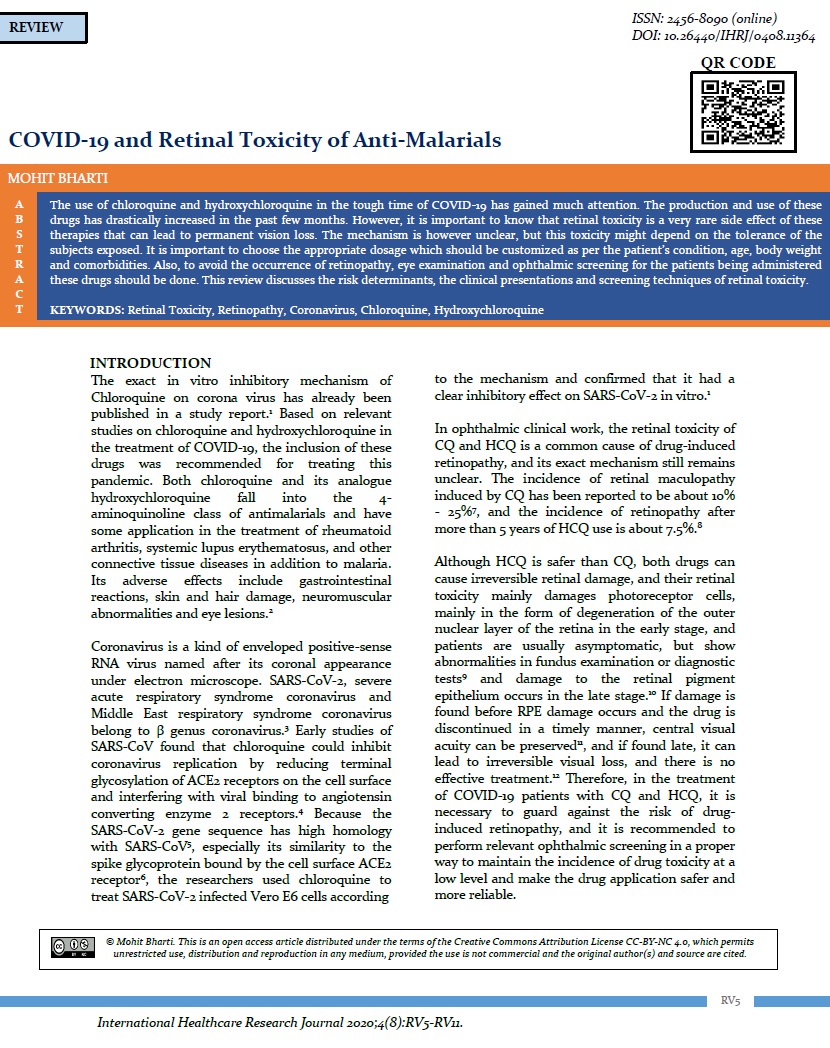COVID-19 and Retinal Toxicity of Anti-Malarials
Abstract
The use of chloroquine and hydroxychloroquine in the tough time of COVID-19 has gained much attention. The production and use of these drugs has drastically increased in the past few months. However, it is important to know that retinal toxicity is a very rare side effect of these therapies that can lead to permanent vision loss. The mechanism is however unclear, but this toxicity might depend on the tolerance of the subjects exposed. It is important to choose the appropriate dosage which should be customized as per the patient’s condition, age, body weight and comorbidities. Also, to avoid the occurrence of retinopathy, eye examination and ophthalmic screening for the patients being administered these drugs should be done. This review discusses the risk determinants, the clinical presentations and screening techniques of retinal toxicity.
Downloads
References
Wang M, Cao R, Zhang L et al. Remdesivir and chloroquine effectively inhibit the recently emerged novel coronavirus (2019-nCoV) in vitro. Cell Res. 2020;30(3):269-71.
Jorge A, Ung C, Young LH et al. Hydroxychloroquine retinopathy-implications of research advances for rheumatology care. Nat Rev Rheumatol 2018;14(12):693-703.
Carlos WG, Dela Cruz CZ, Cao B et al. Novel Wuhan (2019-nCoV) Coronavirus. Am J Respiratory Crit Med. 2020;201 (4): 7-8.
Lan J, Ge J, Yu J et al. Structure of the SARS-CoV-2 spike receptor binding domain bound to the ACE2 receptor. Nature 2020;581 (7807):215-20.
Zhou P, Yang XL, Wang XG, et al. A pneumonia outbreak associated with new coronavirus of probablw bat origin. Nature 2020; 579(7798):270-3.
Xu X, Chen P, Wang, J et al. Evolution of the novel coronavirus from the ongoing Wuhan outbreak and modelling of its spike protein for risk of human transmission. Sci China Life Sci. 2020;63(3):457-60.
Finbloom DS, Silver K, Newsome DA, et al. Comparison of hydroxychloroquine and chloroquine use and the development of retinal toxicity. J Rheumatol. 1985;12(4):692-4.
Melles RB, Marmor MF. The risk of toxic retinopathy in patients on long term hydroxychloroquine therapy. JAMA Ophthalmol. 2014;132(12):1453-60.
Nika M, Blachley TS, Edwards P et al. Regular examinations for toxic maculopathy in long term chloroquine or hydroxychloroquine users. JAMA Ophthalmol. 2014; 132(10):1199-208.
Marmor MF. Comparison of screening procedure in hydroxychloroquine toxicity. Arch Ophthalmol. 2012;130(4):461-9.
Marmor MF, Hu J. Effect of disease stage on progression of hydroxychloroquine retinopathy. JAMA Ophthalmol. 2014;132(9):1105-12.
Marmor MF, Melles RB. Hydroxychloroquine and the retina. JAMA Ophthalmol. 2015;313(8):847-8.
Rosenthal AR, Kolb H, Bergsma D, et al. Chloroquine retinopathy in the rhesus monkey. Invest Ophthalmol Vis Sci. 1978;17(12):1158-75.
Xu C, Zhu L, Chan T, et al. Chloroquine and hydroxychloroquine are novel inhibitors of human organic anion transporting polypeptide 1A2. J Pharm Sci. 2016;105(2):884-90.
Lee MG, Kim SJ, Ham DI, et al. Macular retinal ganglion cell inner plexiform layer thickness in patients on hydroxychloroquine therapy. Invest Ophthalmol Vis Sci. 2014;56(1): 396-402.
deSisterness L, Hu J, Rubin DL, et al. Localization of damage in progressive hydroxychloroquine retinopathy on and off the drug: inner versus outer retina, parafovea versus peripheral fovea. Invest Ophthalmol Vis Sci. 2015; 56(5)3415-26.
Korthagen NM, Bastiaans J, vanMeurs JC, et al. Chloroquine and hydroxychloroquine increase retinal pigment epithelial layer permeability. J Biochem Mol Toxicol. 2015;29(7):299-304.
Chen TY, Lien WC, Cheng HL, Kuan TS, Sheu SY, Wang CY. Chloroquine inhibits human retina pigmented epithelial cell growth and microtubule nucleation by downregulating p150glued. J Cell Physiol. 2019;234(7):10445-7. https://doi.org/10.1002/jcp.27712.
Yusuf IH, Sharma S, Luqmani R, Downes SM. Hydroxychloroquine retinopathy. Eye (Lond). 2017;31(6):828-45. https://doi.org/10.1038/eye.2016.298.
Li X, Fei J, Lei Z, et al. Chloroquine impairs visual transduction via modulation of acid sensing ion channel 1a. Toxicol Lett. 2014;228(3):200-6.
Marmor MF, Kellner U, Lai TY, Melles RB, Mieler WF. American Academy of Ophthalmology. Recommendations on Screening for Chloroquine and Hydroxychloroquine Retinopathy (2016 Revision). Ophthalmology. 2016;123(6):1386-94.
Leung LS, Neal JW, Wakelee HA, Sequist LV, Marmor MF. Rapid Onset of Retinal Toxicity From High-Dose Hydroxychloroquine Given for Cancer Therapy. Am J Ophthalmol. 2015;160(4):799-805.e1. https://doi.org/10.1016/j.ajo.2015.07.012.
Navajas EV, Krema H, Hammoudi DS, Lipton JH, Simpson ER, Boyd S, Easterbrook M. Retinal toxicity of high-dose hydroxychloroquine in patients with chronic graft-versus-host disease. Can J Ophthalmol. 2015;50(6):442-50.
Gao J, Tian Z, Yang X. Breakthrough: Chloroquine phosphate has shown apparent efficacy in treatment of COVID-19 associated pneumonia in clinical studies. Biosci Trends. 2020 16;14(1):72-73.
Marmor MF, Kellner U, Lai TY, Lyons JS, Mieler WF. American Academy of Ophthalmology. Revised recommendations on screening for chloroquine and hydroxychloroquine retinopathy. Ophthalmology. 2011;118(2):415-22.
Chiang E, Jampol LM, Fawzi AA. Retinal toxicity found in a patient with systemic lupus erythematosus prior to 5 years of treatment with hydroxychloroquine. Rheumatology (Oxford). 2014;53(11):2001. https://doi.org/10.1093/rheumatology/keu317.
Chen N, Zhou M, Dong X, Qu J, Gong F, Han Y, et al. Epidemiological and clinical characteristics of 99 cases of 2019 novel coronavirus pneumonia in Wuhan, China: a descriptive study. Lancet. 2020;395(10223):507-13.
Shroyer NF, Lewis RA, Lupski JR. Analysis of the ABCR (ABCA4) gene in 4-aminoquinoline retinopathy: is retinal toxicity by chloroquine and hydroxychloroquine related to Stargardt disease? Am J Ophthalmol. 2001;131(6):761-6.
Grassmann F, Bergholz R, Mändl J, Jägle H, Ruether K, Weber BH. Common synonymous variants in ABCA4 are protective for chloroquine induced maculopathy (toxic maculopathy). BMC Ophthalmol. 2015;15:18.
Lee JY, Vinayagamoorthy N, Han K, Kwok SK, Ju JH, Park KS, et al. Association of Polymorphisms of Cytochrome P450 2D6 With Blood Hydroxychloroquine Levels in Patients With Systemic Lupus Erythematosus. Arthritis Rheumatol. 2016;68(1):184-90.
Modi YS, Singh RP. Bull's-Eye Maculopathy Associated with Hydroxychloroquine. N Engl J Med. 2019;380(17):1656.
Kellner S, Weinitz S, Farmand G, Kellner U. Cystoid macular oedema and epiretinal membrane formation during progression of chloroquine retinopathy after drug cessation. Br J Ophthalmol. 2014;98(2):200-6.
Melles RB, Marmor MF. Pericentral retinopathy and racial differences in hydroxychloroquine toxicity. Ophthalmology. 2015;122(1):110-6.
Lee DH, Melles RB, Joe SG, Lee JY, Kim JG, Lee CK, Yoo B, Koo BS, Kim JT, Marmor MF, Yoon YH. Pericentral hydroxychloroquine retinopathy in Korean patients. Ophthalmology. 2015;122(6):1252-6.
Chen E, Brown DM, Benz MS, Fish RH, Wong TP, Kim RY, et al. Spectral domain optical coherence tomography as an effective screening test for hydroxychloroquine retinopathy (the "flying saucer" sign). Clin Ophthalmol. 2010;4:1151-8.
Easterbrook M. An ophthalmological view on the efficacy and safety of chloroquine versus hydroxychloroquine. J Rheumatol. 1999;26(9):1866-8.
Paim-Marques L, Carneiro P, Verçosa IC, Appenzeller S. Corneal vortex keratopathy in childhood-onset systemic lupus erythematosus (c-SLE). Clin Rheumatol. 2019;38(10):2851-5.
Lacava AC. Ocular complications of chloroquine and derivatives therapy. Arq Bras Oftalmol. 2010;73(4):384-9.
Lai TY, Ngai JW, Chan WM, Lam DS. Visual field and multifocal electroretinography and their correlations in patients on hydroxychloroquine therapy. Doc Ophthalmol. 2006 May;112(3):177-87.
Maturi RK, Yu M, Weleber RG. Multifocal electroretinographic evaluation of long-term hydroxychloroquine users. Arch Ophthalmol. 2004;122(7):973-81.
Lyons JS, Severns ML. Using multifocal ERG ring ratios to detect and follow Plaquenil retinal toxicity: a review : Review of mfERG ring ratios in Plaquenil toxicity. Doc Ophthalmol. 2009;118(1):29-36.
Kellner U, Renner AB, Tillack H. Fundus autofluorescence and mfERG for early detection of retinal alterations in patients using chloroquine/hydroxychloroquine. Invest Ophthalmol Vis Sci. 2006;47(8):3531-8.
Missner S, Kellner U. Comparison of different screening methods for chloroquine/hydroxychloroquine retinopathy: multifocal electroretinography, color vision, perimetry, ophthalmoscopy, and fluorescein angiography. Graefes Arch Clin Exp Ophthalmol. 2012;250(3):319-25.
Eldeeb M, Chan EW, Omar A. Case Report: Hydroxychloroquine Retinopathy. Optom Vis Sci. 2018;95(6):545-9.
Nair AA, Marmor MF. ERG and other discriminators between advanced hydroxychloroquine retinopathy and retinitis pigmentosa. Doc Ophthalmol. 2017 Jun;134(3):175-83.

Copyright (c) 2020 Satya dantala

This work is licensed under a Creative Commons Attribution-NonCommercial 4.0 International License.


